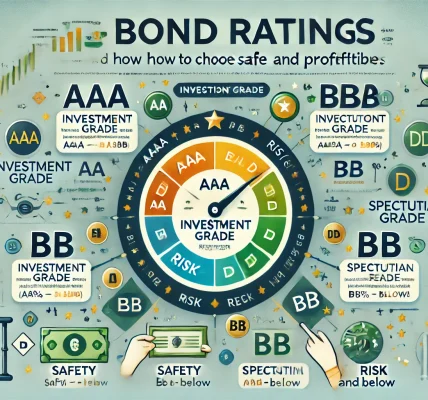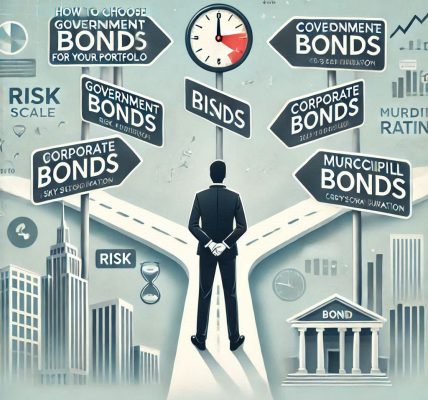Bonds are a popular investment vehicle for those seeking predictable income and lower volatility compared to stocks. However, one critical factor that can significantly impact the value of bonds is interest rate changes. As interest rates fluctuate, bond prices react inversely, creating opportunities and risks for investors.
This comprehensive guide explains how interest rates influence bond prices, explores the reasons behind this inverse relationship, and offers actionable insights to help investors navigate changing interest rate environments.
🎯 Understanding the Basics: Bonds and Interest Rates
💡 What is a Bond?
A bond is a fixed-income instrument where an investor lends money to an issuer (such as a corporation or government) in exchange for periodic interest payments and the return of the principal amount at maturity.
📊 Key Bond Terms to Know:
- Face Value (Par Value): The amount the bondholder receives at maturity.
- Coupon Rate: The annual interest rate paid by the bond, expressed as a percentage of the face value.
- Yield to Maturity (YTM): The total return an investor can expect if the bond is held until maturity.
- Market Price: The price at which a bond is currently trading in the market.
📈 The Inverse Relationship: Why Do Bond Prices Move Opposite to Interest Rates?
🔄 How It Works:
When interest rates rise, newly issued bonds offer higher yields, making existing bonds with lower coupon rates less attractive. As a result, the market price of older bonds falls to align their yields with newly issued bonds.
Conversely, when interest rates fall, older bonds with higher coupon rates become more attractive, leading to an increase in their market price.
📊 Example to Illustrate:
- Suppose you purchase a 10-year bond with a face value of ₹10,000 and a coupon rate of 5%.
- If market interest rates increase to 6%, new bonds offer a higher yield. To sell your bond, you would need to lower the price so that it offers an equivalent return.
- On the other hand, if interest rates drop to 4%, your bond becomes more attractive, increasing its market value.
🔍 Why Do Bond Prices and Interest Rates Have an Inverse Relationship?
📚 Mathematics Behind Bond Pricing
Bond prices are calculated by discounting future cash flows (coupon payments and the principal amount) back to the present using the prevailing market interest rate.
When interest rates rise:
- Future cash flows are discounted at a higher rate.
- The present value of the bond decreases, leading to a drop in price.
When interest rates fall:
- Future cash flows are discounted at a lower rate.
- The present value of the bond increases, leading to a rise in price.
📉 Impact of Interest Rate Changes on Different Types of Bonds
1️⃣ Short-Term vs. Long-Term Bonds
- Short-Term Bonds: Less sensitive to interest rate changes due to shorter durations.
- Long-Term Bonds: Highly sensitive to interest rate fluctuations, resulting in greater price volatility.
💡 Key Insight: Long-term bonds may offer higher yields, but they are more exposed to interest rate risk.
2️⃣ Government Bonds vs. Corporate Bonds
- Government Bonds: Often considered safer, but still subject to interest rate fluctuations.
- Corporate Bonds: May offer higher yields but carry additional credit risk along with interest rate sensitivity.
3️⃣ Zero-Coupon Bonds
Zero-coupon bonds are highly sensitive to interest rate changes because they do not make periodic coupon payments. Their price fluctuations are driven primarily by changes in interest rates.
📊 How Interest Rate Changes Affect Bond Yields
🔄 Understanding Yield to Maturity (YTM)
- Yield Increases: When bond prices fall, yields rise, as the investor receives the same coupon payment but at a lower purchase price.
- Yield Decreases: When bond prices rise, yields fall, as the bond becomes more expensive relative to its coupon payment.
📊 Formula to Calculate Yield:
Yield=Coupon PaymentCurrent Bond Price\text{Yield} = \frac{\text{Coupon Payment}}{\text{Current Bond Price}}Yield=Current Bond PriceCoupon Payment
🛡️ Strategies to Mitigate Interest Rate Risk
✅ 1. Diversify Your Bond Portfolio
Holding a mix of short-term, medium-term, and long-term bonds can spread the impact of interest rate changes and reduce overall volatility.
✅ 2. Build a Bond Ladder
A bond ladder involves purchasing bonds with staggered maturities. As bonds mature, the proceeds can be reinvested at prevailing interest rates, mitigating reinvestment risk.
✅ 3. Consider Floating Rate Bonds
Floating rate bonds have interest rates that adjust periodically based on a benchmark rate. They offer protection against rising interest rates.
✅ 4. Invest in Bond Funds or ETFs
Bond funds or exchange-traded funds (ETFs) provide diversification and professional management, reducing exposure to individual bond price volatility.
⚠️ Risks to Watch Out for During Interest Rate Changes
🚨 1. Reinvestment Risk
When interest rates fall, maturing bonds may be reinvested at lower rates, reducing overall income.
🚨 2. Duration Risk
Longer-duration bonds are more sensitive to interest rate changes, leading to larger price fluctuations.
🚨 3. Inflation Risk
If inflation outpaces bond yields, the real return on bonds diminishes, eroding purchasing power.
📢 How Investors Can Leverage Interest Rate Cycles
📈 When Interest Rates Are Rising:
- Opt for short-duration bonds to reduce exposure to falling prices.
- Consider floating rate bonds to benefit from rising rates.
- Avoid locking in long-term bonds at low yields.
📉 When Interest Rates Are Falling:
- Lock in long-term bonds to secure higher coupon rates.
- Explore zero-coupon bonds to benefit from falling rates.
- Reinvest maturing bonds in higher-yield options before rates decline further.
📋 Legal Considerations When Discussing Bond Investments
⚠️ 1. Avoid Giving Personalized Investment Advice
Always present content as educational information and avoid making specific recommendations tailored to individual investors.
⚠️ 2. Disclose Risks and Limitations
Clearly state that bond prices and yields are subject to market fluctuations and that past performance is not indicative of future results.
⚠️ 3. Emphasize Due Diligence
Encourage readers to conduct their own research or consult a financial advisor before making investment decisions.
📊 Summary: Key Takeaways
- Interest rate changes have an inverse impact on bond prices. When rates rise, bond prices fall, and vice versa.
- Long-term bonds are more sensitive to interest rate changes than short-term bonds.
- Diversification, bond ladders, and floating rate bonds can mitigate interest rate risk.
- Investors should align their bond investment strategies with their risk tolerance and financial goals.
By understanding how interest rates impact bond prices, investors can make informed decisions and build a resilient fixed-income portfolio.
🎯 Final Thoughts
Understanding the dynamics between interest rates and bond prices equips investors with the knowledge needed to make informed decisions. By adopting strategies such as bond ladders or investing in floating rate bonds, investors can effectively manage interest rate risk while optimizing returns.
Would you like me to create another detailed blog or generate more visual content for your website? 😊




